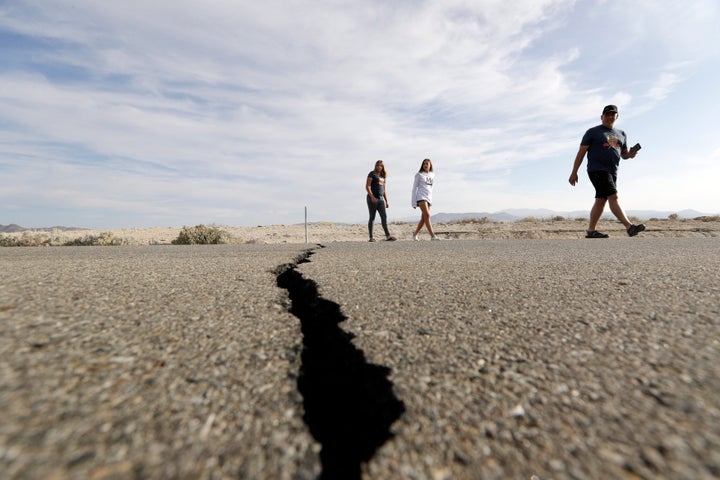California is tense after a progression of serious seismic tremors shook the locale during the occasion end of the week. While harm was generally minor, many quakes have kept on shaking the locale and authorities have asked Californians to reevaluate their readiness for the following “huge one.”
This is what you have to think about delayed repercussions, how precisely researchers can gauge future seismic tremors and how you should get ready for any catastrophic events.
So, what happened?
California was hit by consecutive quakes over the Fourth of July occasion. On Thursday, a 6.4 extent tremor struck close to a little, rustic town in Southern California called Ridgecrest, around 150 miles from Los Angeles. The following day, a bigger 7.1 size earthquake hit a similar region and was felt by millions over the district, from Dodger Stadium in Los Angeles down to Mexico and eastbound to Las Vegas.
There has been a constant flow of littler extent consequential convulsions throughout the end of the week, including 297 tremors that were size 3 or higher, as indicated by the most recent readings from the U.S. Geographical Survey.
Is it true that anyone was harmed, and what amount of harm was there?
There have been no reports of any significant wounds or passings, and authorities have given the occasion a role as an opportune cautioning for the state. Specialists have discovered some harm to homes and organizations in Ridgecrest and an adjacent town, just as streets that were broken by the tremors. Yet, real urban communities like Los Angeles evaded any significant mischief.

The quakes were centered around the small town of Ridgecrest, about 150 miles from Los Angeles. There were no major injuries or deaths.
“We’re very lucky there and happy there wasn’t anything worse,” Mark Ghilarducci, director of the California Governor’s Office of Emergency Services, or OES, told The Los Angeles Times.
California Gov. Gavin Newsom (D) has requested a presidential emergency declaration after the event, declaring a state of emergency in the Ridgecrest area. He offered his sympathies to those affected by the quakes, pledging recovery resources to deal with any damage.
“It is a wake-up call for the rest of the state and other parts of the nation, frankly,” Newsom said at a press conference on Saturday.
Residents have reported being on edge following the twin quakes and the aftershocks.
Are more seismic tremors or delayed repercussions anticipated?
Right off the bat, researchers can’t superbly foresee the time or spot of a quake. Or maybe, seismologists use information and measurable examination to gauge how likely another quake might be, the USGS notes.
The office’s flow figure takes note of there’s not exactly a 1 percent possibility of at least one consequential convulsions bigger than size 7.1 throughout the following week. Those measurements likewise state there’s around a 2 percent shot for a shake of such greatness throughout the following year. Starting figures were fundamentally bigger, with certain seismologists guaging around a 1 of every 10 possibility of another huge tremor, yet they decline after some time.
“The quantity of post-quake tremors will drop off after some time, however, an enormous delayed repercussion can build the numbers once more, incidentally,” the USGS said. “The normal numbers and probabilities of post-quake tremors have gone down since the past conjectures for two reasons. To begin with, it is because of the normal and expected to diminish in action over the long haul since the mainshock. Second, our perceptions of this consequential convulsion arrangement demonstrate that the movement is diminishing marginally more rapidly than normal for this zone.”
Dr. Lucy Jones, a seismologist at the California Intestate of Technology sometimes called the “earthquake lady,” also noted on Twitter Sunday that while the number of aftershocks decreases over time, it that doesn’t mean they won’t happen. She wrote that “large, late aftershocks show up in most sequences,” pointing to 1994’s Northridge earthquake. The last aftershock in that sequence took place years later in 1997.
“We’re going to have a magnitude 6, on average, somewhere in Southern California every few years. We’ve actually gone 20 years without one, so we have had the quietest 20 years in the history of Southern California,” Jones told the Associated Press on Sunday. ““=Geology keeps on moving … and we should be expecting a higher rate. And when it happens near people, it is going to be a lot worse.”
What can you do to prepare?
California emergency officials have urged residents to update their go-bags and emergency supplies following the quakes, particularly due to the pause in major earthquake activity over the past two decades.
“This was a very good wakeup call, essentially,” Robb Mayberry, a public information officer with California OES, told HuffPost. “If it happened in a more urban area it would’ve been more disastrous. As large as it was, it got some attention.”

Emergency officials are encouraging Californians to update their first-aid kits and go-bags after the earthquakes, dubbing them a wake-up call after a period of relative quiet.
Mayberry indicated a group of contemplations for any supply pack, including keeping a couple of shoes by the bed and adding batteries or telephone charges to survival packs so occupants can remain assessed of data during any potential debacle. Los Angeles County has an early cautioning telephone application for such occasions also (despite the fact that it didn’t actuate during a week ago’s shudders, as the effect on the district didn’t meet the limit).
The Los Angeles Times takes note of that under 12 percent of California occupants to have protection arrangements that spread seismic tremors. Enthusiasm for such inclusion more often than not spikes following significant occasions before plunging. The outlet detailed that at the season of the Northridge tremor, 33 percent of Californians had shudder protection. Somewhere in the range of 2012 and 2016, that number was under 11 percent every year.






